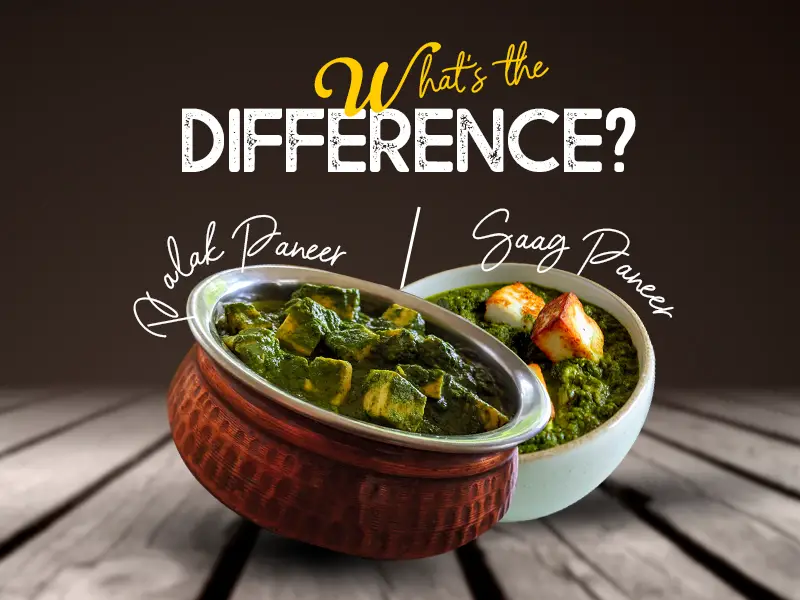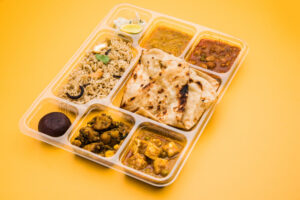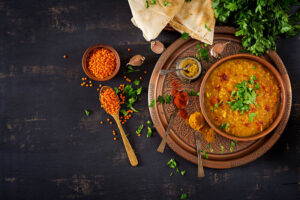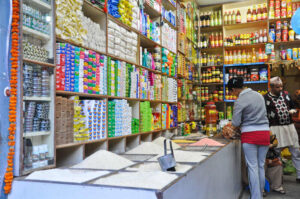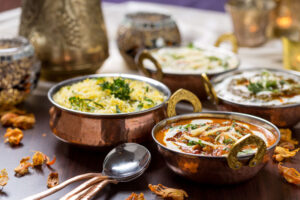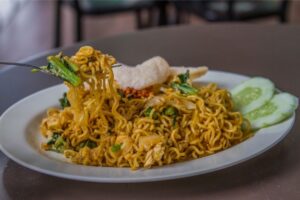Introduction: When The Greens Scream “Paneeeer”
Palak paneer vs saag paneer is something even culinary experts sometimes get confused over. However, these curries are an essential part of Indian cuisine and are slowly gaining popularity in the US. Both these curries have their respective fan following, thanks to the presence of store-bought or homemade paneer, spinach leaves, and heavy cream.
The main difference between palak paneer and saag paneer can be attributed to the cooking ingredients. Saag paneer requires a blended form of many leafy vegetables known as “saag” in India. On the other hand, ‘palak’ or fresh spinach is the main ingredient for making palak paneer.
The similarity between palak paneer vs saag paneer is the presence of cottage cheese in a rich gravy (most probably dark green).In addition, the leafy green vegetables are health boosters, making the dishes a go-to choice for a majority of the American population.
If you are confused between these two, read on to know which “greens-savvy” dish emerges out to be the winner!
Is saag paneer the same as palak paneer?

Palak paneer & saag paneer both are nutrient-rich Indian dishes. The main differences between palak paneer and saag paneer are their color and similar ingredients. The latter also doesn’t require cream or yogurt for its preparation.
The purpose of making saag paneer is to combine the nutritional value of all the leafy greens with Indian cheese. It may not be liked by many (especially children due to its high concentration of greens. On the other hand, Palak paneer is well balanced due to the yogurt, spinach puree, and cream in it.
Adding on to this, the milk-based ingredients used in palak paneer also help neutralize the unpleasant taste of leafy greens. This dish is also comparatively easy to prepare with less effort. On the other hand, the preparation of saag paneer is difficult as it is herculean to collect and process all the leafy vegetables.
Fun fact: Both are prepared with different cooking methods and contain a few similar ingredients, but look the same in 80% of the cases!
So saag paneer is not identical to palak paneer, regardless of color and texture. The spices and some ingredients are similar, but preparation is entirely different for both. It is easy to distinguish aroma as well – saag paneer will confuse your nose while palak paneer will lead to a bland sharp nasal sensation.
Here’s a similar showdown between 2 paneer based dishes: paneer makhani vs paneer tikka masala.
Saag Paneer vs Palak Paneer: What Are The Differences?
Palak paneer and saag paneer differ in various aspects. These two food items may look similar to amateur cooks, but they differ in color, taste, and nutrient value.
- Saag paneer provides a higher nutrient value as compared to palak paneer since it is made from a blend of different kinds of green vegetables.
- The number of ingredients required to make palak paneer is significantly less as compared to the number of ingredients required to make saag paneer.
- Saag paneer is a dark-green colored Indian curry with a strong flavor, whereas palak paneer is a light-colored Indian curry with fewer flavors.
- Saag paneer is not available in every season, whereas palak paneer is available throughout the year.
The similarities between palak paneer and saag paneer, owing to their ingredients and origin, are:
- Indian cottage cheese is the main ingredient in both palak paneer and saag paneer.
- Spices such as cumin seeds and coriander seeds are common to saag paneer and palak paneer.
- Palak paneer and saag paneer have a good amount of vitamins and minerals, including all the pros of having greens in an everyday diet.
- Spinach is a leafy green used for saag paneer as well as palak paneer.
- Saag and palak paneer are spicy foods, having a semi-fluid texture.
What Is Saag Paneer?
Saag paneer is a traditional Indian dish but is instead cooked differently in different parts of India. That said, the best way to enjoy it is if you travel to Punjab, India as that’s where it originally comes from. Common variations of this dish are aloo saag, saag gosht and saag chicken. They are all cooked over medium heat.
Don’t worry though. You can still cook it anywhere you like and it will be just as tasty, thanks to the widespread availability of Indian ingredients like baby spinach, green chillies, chilli powder, cumin seeds etc. Aside from the usual green vegetables, some also use radish, mustard leaves, fenugreek leaves, chickpeas, amaranthus leaves, and chenopodium for saag paneer.
Saag paneer is simply authentic and goes well with all kinds of Indian breads. It is on the drier side though so keep in mind that you cannot serve it with rice without any curry or dal.
It also shouldn’t be labelled Saag Paneer on the menu. Saag Paneer is an entirely different dish made with delicious, peppery mustard greens and shouldn’t be confused with the milder-tasting Palak Paneer made with spinach.
— Doesn’t rhyme with banana (@sanjanafeasts) September 18, 2018
What Is Palak Paneer?
Palak paneer has two main ingredients in it – palak (fresh spinach) and cottage cheese (paneer). Its flavors are on the milder side when compared to saag paneer due to the lesser concentration of vegetables used. Another name that this recipe goes by is Green Paneer.
This dish goes well with rice and Indian breads such as naan, tandoori roti and phulkas. It is inclusive of just one “saag” out of the many present in saag paneer. Here’s the catch to make out the difference – this one has a darker green appearance while saag paneer looks a bit muddy.
Did you know? Palak is infamous in India for sticking to teeth and features in many toothpaste advertisements for its stubborn nature – the one which helps remove its stains wins the stakes! Interesting, right?
Which green paneer is healthier: Palak Paneer vs Saag Paneer
The flavors of spinach or any other leafy vegetable are naturally very appealing. Both palak paneer and saag paneer need proper cooking techniques to extract their nutritional properties. Furthermore, both these curries increase the antioxidant levels in your body.
A pro tip from an Indian kitchen: As per Indian “grandmas”, it is best to cook greens in open pans instead of the pressure cooker as the nutrients are retained in the former case.
- Nutrient content in both saag paneer and palak paneer is different as the choice of leafy greens is limited in the palak one. Saag paneer comes with vitamins, antioxidants, calcium, carbohydrates, iron, and minerals. The presence of multiple veggies in saag paneer makes it a highly nutritious and fulfilling meal (party hosts, take notes). Paneer adds extra nutrition to the saag (leafy green curry), making it a much-needed protein combo. Gym-goers can easily rely on this dish for their daily requirements.
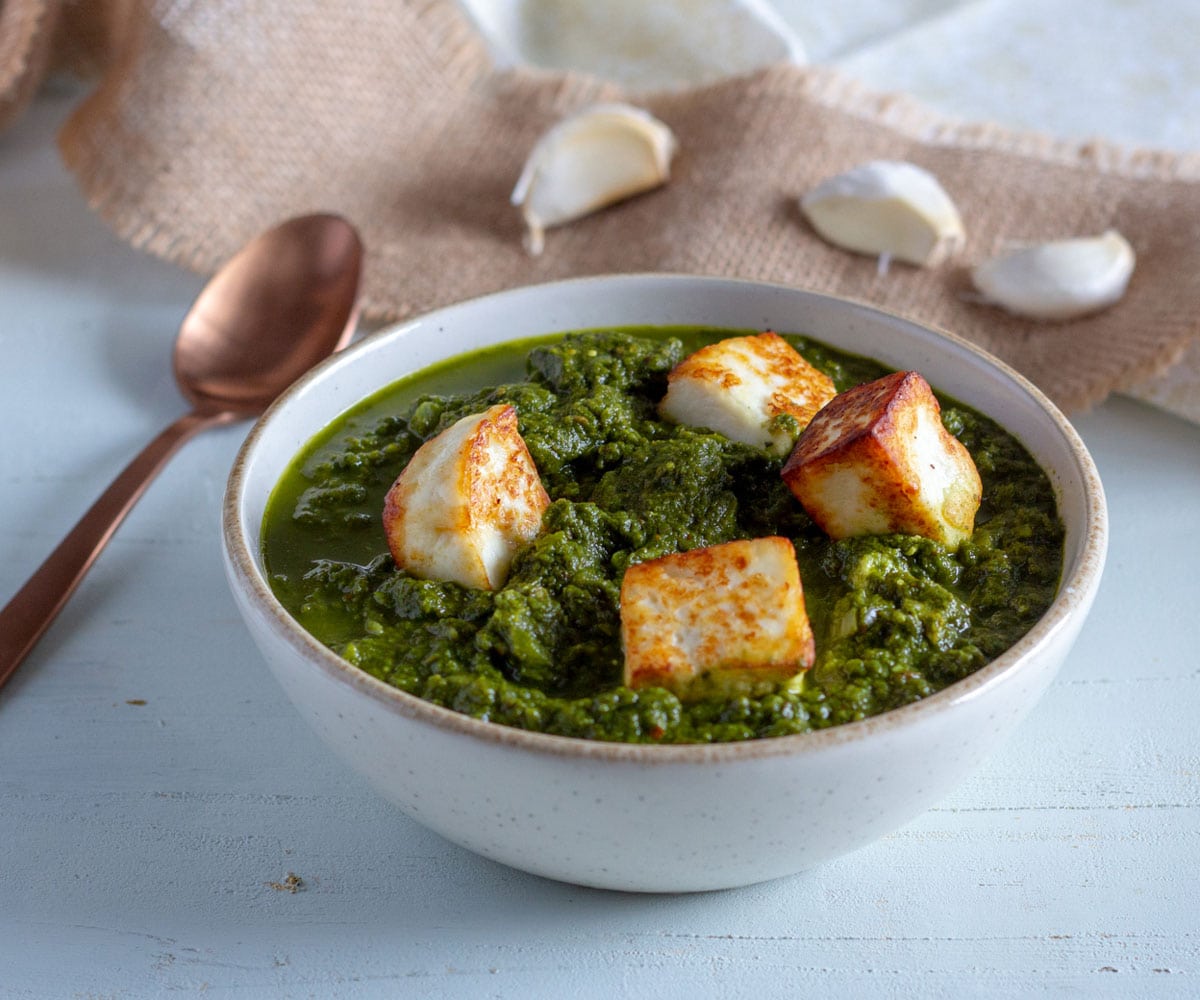
- The nutrient value of palak paneer is slightly less than saag paneer for obvious reasons. Palak paneer contains fresh spinach in limited quantities. Spinach in palak paneer has calcium, iron, minerals, vitamins, proteins, and carbohydrates. At times, people add tomatoes, onions, and garlic too. Cream and yogurt in the palak paneer come with probiotics and good fats, beneficial to the human body.
Did you know? Some Indians, mostly oldies, do not consume onions and garlic throughout their lives and they are seen as sort of “non-veg vegetables”.
Lastly, people who have obesity or cholesterol problems should not consume palak paneer due to the presence of cream in it. Also, it is a big no for Americans suffering from digestive issues. No one would like to binge on laxatives, right?
The following table might serve as a bible for those confused between green paneers:
| Nutrient Value | Saag Paneer | Palak Paneer |
| Calories | 194 calories | 470 calories |
| Fat (total) | 10.4 g | 24 g |
| Cholesterol | 31 mg | 2.5 mg |
| Carbohydrate | 19 g | 14.1 g |
People should eat an adequate amount of saag or palak paneer to avoid repercussions. It might be a big task motivating young ones to consume either of these. Best of luck, mommies!
Which Is More Popular: Saag Vs Palak Paneer?
The popularity of palak paneer or saag paneer depends on season, taste, and place. Palak paneer is popular in India due to its neutralized flavors and richness. The availability of palak in every season further makes it popular in many areas. However, as per Indian beliefs, it should not be consumed in the rainy season (check as per your location, irrespective of cold storage) as the leaves are mostly infested with small worms.
Wondering how to ensure that your palak is safe to consume? Here’s a solution right from Indian street vendors – if the leaf has tiny irregular holes, it is unsafe to consume. The same goes for other saag alternatives too.
The taste of palak paneer is more popular as it has cream and yogurt in it. The young generation would most likely prefer to have palak paneer over saag paneer . In foreign countries too, palak paneer is famous as the ingredients of this vegetarian dish are available easily. Just blanch it and switch on the blender!
Is saag paneer healthy?
Yes, saag paneer is one of the healthiest Indian dishes, brimming with all the vitamins the human body needs in a day. So, if you want to get the maximum nutrients present in frozen spinach, mustard greens, paneer cubes and collard greens, then saag paneer is the best for you.
How long does saag paneer last?
The shelf life of the saag paneer depends on its storage. It can last for upto three days if kept in a refrigerator whereas without it, it stays fresh for about 5-6 hours.
Confused about paneer consumption during pregnancy? Here are common paneer pregnancy myths busted.
Is saag paneer bad for you?
If you are not gluten-allergic, then saag paneer is healthy. The nutrient value of leafy green and cottage cheese would boost your health exceptionally well. Lactose intolerant people also steer clear from this recipe, or any kind of paneer in general.
Many fitness enthusiasts even use saag paneer for ketogenic diets. Here’s a tasty saag paneer keto recipe.
What else can I make with palak paneer?

You can make palak paneer pulao and roti with the leftover palak paneer. To make the roti or chapati with some palak paneer, you need to mix the paneer and spinach gravy with wheat flour (without using hot water). The dough would come out green (Halloween party sides, sorted).
What spices are in saag paneer?
Black peppers, cumin seeds, cinnamon, coriander seeds, and cloves are some of the spices used. Bay leaves are also used in traditional Indian households.
How to eat saag paneer?
You can enjoy the saag paneer with bread or naan. Brown rice also goes well with this one and it further enriches the nutritional value. Saag paneer would go well as a part of multi-course Indian meals.
Another hack: Take a small piece of bread, fold it in half, place paneer in between (sandwiching), and dip the same into the gravy before eating. Enjoy!
Hope you now know what to pick between palak paneer vs saag paneer. Thanks for reading.
Read on to find out everything about paneer.
